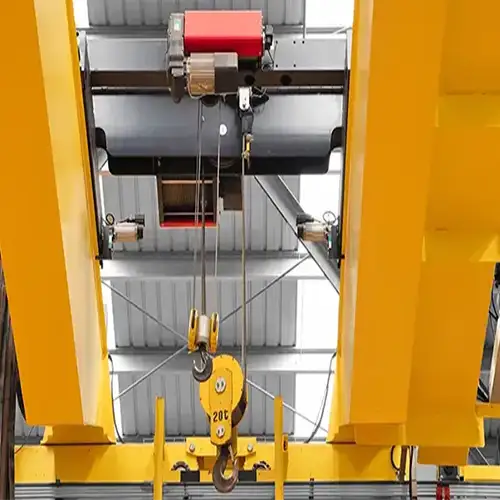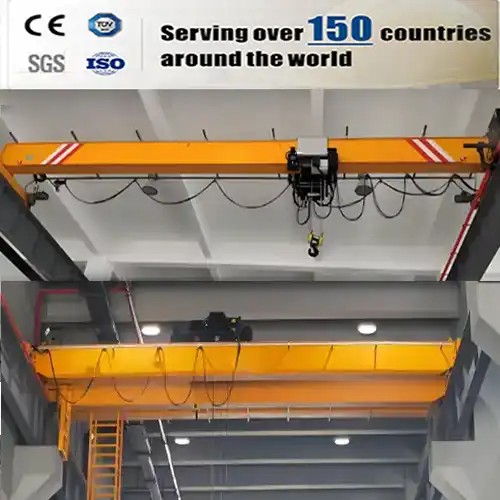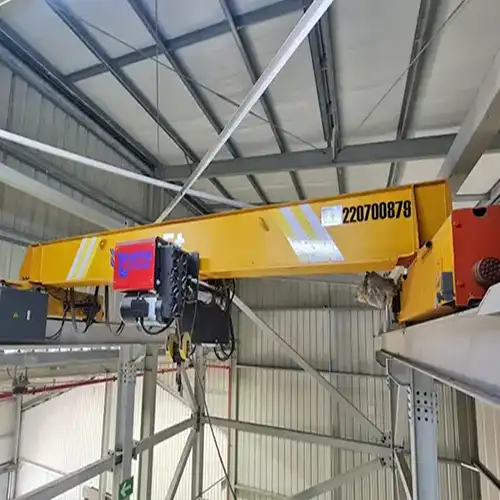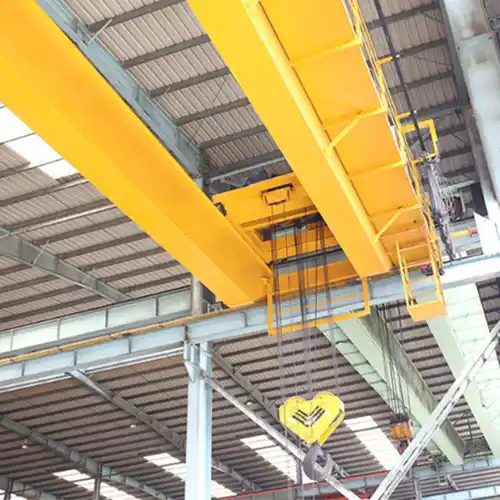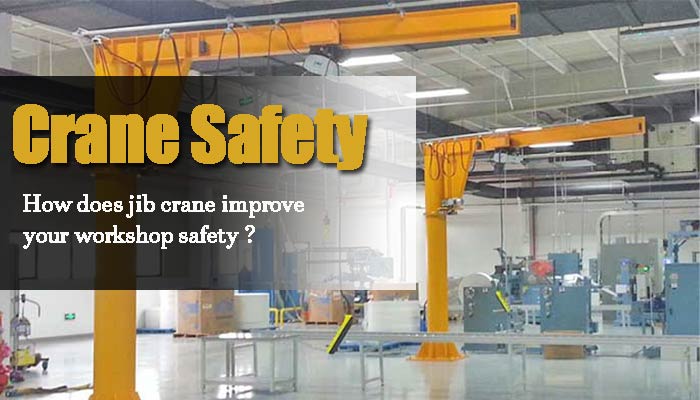
How Do Jib Cranes Improve Your Workshop Safety?
What is a jib crane and how does it work? It's a crane with a horizontal member, also called a jib or boom. The jib is a crane's horizontally extending operational arm. The jib's job is to support a moveable hoist that is attached to a wall or pillar on the floor. It's primarily employed in industrial settings.
The jib usually swings in an arc or is fastened in a fashion that allows for more lateral mobility. The jib is a tilting strut on the crane that supports the fixed pulley lock.
Cranes are sometimes installed on top of warehouse floors to assist in the lifting of products from the floors to higher levels. Cables are joined to the load multiple times around a fixed block and directly to the load. The unconnected end of the cable is either manually pulled or wound with a winding equipment.
The load is given a force via the pulley system. As a result, the force applied is increased by the length of wire flowing between two blocks. The mechanical advantage is the name of the product.
Jib cranes, in simple terms, are a type of overhead lifting equipment that is typically employed in a limited work cell area for repeated and precise lifting duties.
You must grasp the design of a jib crane once you have a basic understanding of what it is. In comparison to other crane types such as workstation, bridge, and gantry cranes, a jib crane has a basic construction design. They're also a lot easier to operate and don't require as much upkeep.
What are main jib cranes designs?
Jib cranes feature the following components and specs:
- Jib arm/ cantilever: is a horizontal beam on which the trolley moves back and forth. The boom is another name for it. The boom on freestanding and mast jib cranes can rotate up to 360 degrees. On the other hand, the amount of rotation produced by a wall or column-mounted crane is between 180 and 200 degrees.
- Mast: Also known as the pillar, the mast is a vertical column that provides support for the boom on mast or freestanding systems.
- Hoist: This is a moveable component that lifts, positions, and lowers loads.
- Trolley: The trolley transports the hoist, wires, wire rope, chains, and the boom hook. The trolley can be moved manually, mechanically, or pneumatically.
- Electric Collector Rings, sometimes known as pneumatic airlines, are attached to the mast at either the top or bottom. This component's job is to assist with rotation. It also enables the boom to rotate continuously in a 360-degree circle.
- Hook Height: This refers to the lift's ability to travel up or down in height. The higher the hook can travel, the lower the overhead impediment must be.
- The Rotation Stop: This is the part of the jib crane that controls how fast it may move before colliding with neighboring objects.
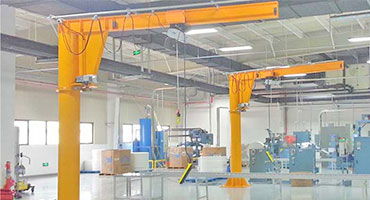
Pillar jib crane
Pillar jib crane specifications-Capacity:0.5 ton -10 ton, Arm length: 3-12m, Lifting height: 3-8m, Rotating : 180, 270, 360 ,Working class: A3.Ask for free standing jib crane price.

Wall mounted jib crane
Wall mounted jib crane specifications-Capacity: 0.25 ton-2 ton, Arm length: 2-6m, Lifting height: 2-6m, Rotating : 180, Working class: A3.Ask for wall mounted jib crane price.
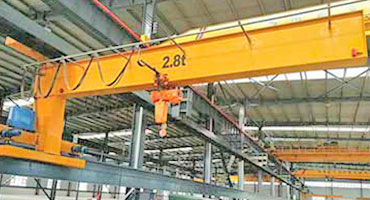
Wall travelling jib crane
Wall-travelling jib crane specifications-Capacity: 0.25 ton-10 ton, Span: 3-10m, Lifting height: 3-8m, Rotating : 180,Working class: A3. Ask for wall travelling jib crane price.
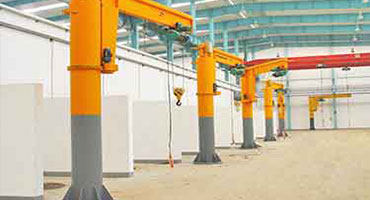
Slewing jib crane
Slewing jib cranes -floor & wall jib cranes- flexible swing or slewing jib arm & rotary crane design, 180, 270 &360 degree rotating jib crane for sale. Ask for slewing jib crane price.
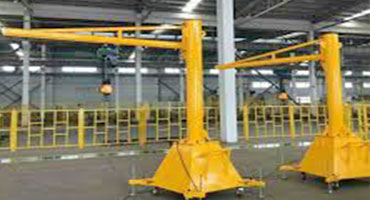
Portable jib crane
Portable jib crane specifications- Capacity: 0.08 ton,1 ton, Lifting Height: 1.5- 3m, Turning Radius: 2m, 3m, Rotation Angle: 360°, Working class: A3.Ask for portable jib crane price.
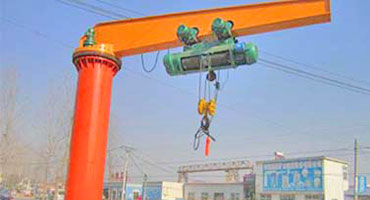
Process jib crane
Process jib cranes for your specific application to lower your jib crane cost. Contact us to get your customized process jib crane design and your jib crane rate and crane price.
How do jib cranes contribute to workplace safety?
Jib cranes can significantly improve the efficiency of your plant or warehouse. Many people, however, are unaware of the numerous safety benefits they can provide to your business. Jib cranes can help you build a safety culture within your company by decreasing injuries and encouraging a seamless training experience. The top four ways jib cranes contribute to workplace safety are listed below.
1) Jib cranes help reduce injury
"In order to reduce workplace injuries and illnesses, occupational safety professionals aim to figure out which ones are the most common and why they happen.... Handling items, substances, or materials that could cause injury accounts for 32% of total claims at The Travelers Companies, Inc. Then there are slips, trips, and falls, which account for 16% of their injuries "asserts."
The most common kind of job injuries are those caused by lifting or manipulating things or materials. Jib cranes can drastically minimize the number of strains, sprains, and other accidents incurred by employees attempting to carry items exceeding 50 pounds by offering a safe means of lifting and moving cargo.
2) Jib cranes help reduce overcrowding
Many warehouses and companies today are overflowing with equipment, merchandise, and personnel. Employees are also at a higher risk of injury in overcrowded facilities. You can increase warehouse space, tidy up cluttered aisles, and assist prevent injury by employing ergonomic jib cranes rather than standard cranes.
3) Less parts equals fewer failures.
While jib cranes are built to be safe, no piece of machinery is impervious to failure. Jib cranes, on the other hand, have a simpler design with a lesser number of components, making them less likely to break down and potentially injure an operator or other worker nearby.
4) A more straightforward design encourages effective safety instruction.
When introducing a jib crane or any new piece of equipment to your production team, safety should always come first. Jib cranes are easier to operate because of their simple design. Because there are fewer moving parts, employees can quickly learn how to operate the machine and do routine inspections.
What should you think about before purchasing a jib crane?
You may be wondering which sort of jib crane would be the greatest fit for your application, given the list of advantages listed above. To answer this question, carefully assess the space you intend to use in conjunction with the objectives you want to achieve with your crane. When deciding which sort of jib crane will best fit your needs, keep the following aspects in mind:
- Needs for structural support: Before you choose a model, be sure your wall or floor can hold the crane.
- Power requirements: Take into account your existing and future power needs, as not all models come with a motorized alternative.
- Your financial situation: Wall mount variants are generally less expensive because they do not require the installation of a floor foundation.
- Time to install a jib crane: Jib cranes are time-consuming to install. Because a foundation must often be poured, floor mount models take longer.
- Delivery time: If you need a jib crane soon, look for a crane that can be delivered in five days or less.
What is the most effective method for obtaining ergonomic jib cranes?
Jib cranes, as previously said, serve an important role in increasing production and workplace safety. Jib cranes, on the other hand, are not all made equal. The best method to make sure you get a dependable jib crane is to buy it from a professional in the ergonomic lifting sector. We have been the nation's most trusted provider of ergonomic jib cranes with over 34 years of expertise selling jib cranes to manufacturers and industrial organizations. The crane professionals are eager to help you with all of your lifting and fall safety needs!
